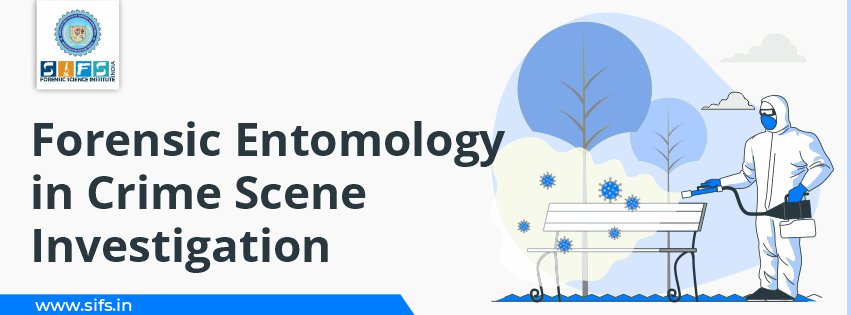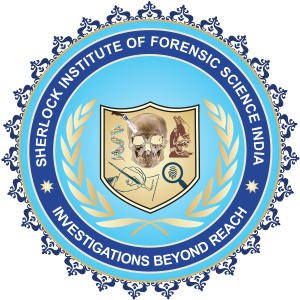- Call Us: +91 7303913002
- Email Us: education@sifs.in
Forensic Entomology in Crime Scene Investigation

BY SIFS India | February 01, 2025
Forensic Entomology in Crime Scene Investigation
Forensic entomology is the study of arthropods which have application in crime scene investigation as a method of predicting post-mortem interval (PMI) in deceased or missing individuals.
PMI is determined by the life stage of insects present on crime scene. Insects used in criminal investigations are primarily beetles, flies, or moths; this may also include various scavenging insects and hitchhiking mites.
These creatures help colonize decayed tissue, providing crime scene personnel with live specimens collected and examined for biological evidence.
Currently, forensic entomology is a niche application in most investigations, as qualified entomologists are often needed where proper analysis of collected evidence is needed which can be complex; however, with time, this forensic subdiscipline is of valuable importance as insect populations rise alongside global temperatures.
Forensic Entomology is the study of insect and other arthropods biology in criminal matters which is slowly becoming a more prevalent tool in solving crimes in the modern era.
As we know insects provide valuable insight to the rate of a corpse’s decomposition and clues to triangulate a victim’s last known location. Additionally, these evidences can be easily captured and examined on-scene or off-site to frisk for a victim’s DNA with greater ease and legality than a human perpetrator.
There is no specific training required in an insect collection.
Investigating personnel can easily learn basic specimen collection and insects’ reliable sources which colonize all aspects of a body making them more readily available for collection due to their widespread availability and large population numbers.
For these reasons, forensic entomology should be a more commonly applied crime-solving technique.
Forensic entomology is a valuable subdiscipline of forensic science, primarily used for estimating the post-mortem interval (PMI), or time elapsed since death, of a deceased individual.
It can be studied in form of decomposition stages, successive patterns of arthropods (insects) over time, or estimating the approximate ages of immature insect specimens found on the crime scenes.
However, this field is still relatively unexplored, which require further studies to better understand its use in field as well as lab work. The dominant reason for using insects in crime scene investigations involving death is to find corpses.
After committing a murder or witnessing an unlawful death, the perpetrator usually attempts to dispose of, or hide, the evidence under fear of repercussions.
Dead Bodies are commonly hidden by burial; however, the perpetrator often underestimates the amount of effort needed to make a proper trench, which generally results in shallow graves.
Nearby insects can easily colonize on these dead bodies which are mainly beetles and flies whose distinct life cycles can be directly related to different decomposition stages.
Through these insects, forensic experts can easily determine the number of issues related to the deceased individual, such as the deceased’s approximate post-mortem interval (PMI), the sanitary conditions of the crime scene and the deceased, possible food or drugs in a victim’s system, and the presence of physical abuse or neglect.
There are many factors that affect dead bodies include weather, environmental changes, or physical obstacles (e.g., water or plastic).
One of the factors is burial environments which directly affect dead bodies are: the presence or absence of a coffin, shroud or clothing, depth, soil composition— pH, temperature, moisture levels and the body’s physical condition.
The use of insects as crime-solving tools primarily revolves around their application in finding and examining cadavers.
Insects generally prefer freshly killed or decaying flesh over live tissue and will be found in increasing quantities the longer the body decays in one place, which can help investigators in finding the body and estimate how long since death occurred.
When insects or pollen grains found on cadavers, if found non-native to the area, can be compared to the closest geographical location with insects or pollen and examined for signs the body was moved from there.
The life stage of at least one of the non-native insect specimens can also be examined to gauge approximately how long ago the body was moved.
A corpse may attract different insect species depending on the stage of decay, meaning multiple insect species may choose to visit, inhabit, and feed on the corpse over long periods.
The successive insect waves provide an approximate timeline of infestation, with flies generally arriving and laying eggs first, then beetles, then moths and other insects.
Crime scene investigation using forensic entomology involves the finding, collecting, and possible identification of a deceased individual’s remains using insects.
There are two main methods of insect use to determine an approximate time lapse since death: successive waves of insects or maggot age and development.
Maggots provide information on general corpse freshness by collecting and examining maggot specimens, eggs, and egg cases to determine the life stage, which helps in gauging the approximate start of body colonization.
In the study of Anderson (2004) states that, for corpses dead for between a month and up to a year or more, successional insect waves are used.
The second method is using maggot age and development as an approximate time frame is used when the death occurred less than a month before discovery.
Insects inhabiting a corpse need to make incision points for entries and exits, and the resulting orifices are usually made in soft tissue such as skin covering a strip of muscle.
Soft tissue rots faster than hard tissue such as bone and is prone to external trauma such as bruising or tearing that can make convenient entrances for hungry insects.
The first fly to reach the corpse is Flesh flies, known for eating live animal flesh, are utilized in medical science as a method for treating gangrenous tissue but may also be useful in examining a recovered missing individual in case of a long-term untreated injury.
The blowfly larvae that colonize a corpse will ingest small amounts of the drug as they grow and consume dead tissue, and the ingested drugs may delay larval development rates.
Therefore, blowflies help in determine deceased individuals' PMI and test for trace amounts of drugs in the victim’s system due to poisoning or intentional ingestion for suicide; (Universiti Teknologi MARA [UiTM], 2014).
Another fly to came is moths may use cloth fibres found on cadavers as an additional food source, and if a body is sufficiently dry and brittle, may choose to nest inside an available body cavity.
Their furred wing scales may also be found dusted across clothing surfaces or skin, making it possible to identify certain species based on scale patterns.
Beetles are found mainly in two categories regarding human corpses: skin beetles (Dermestid) and bone beetles (Cleridae), with both also found buried in muscle tissue.
These beetles can be present in varying quantities in decomposing remains more commonly in dried bodies than wet with most species being scavengers willing to eat, among other animal products: the skin, hair, various fibres, and the remains of other animals and insects when available (Jacobs, 2013).
Forensic entomology is a valuable tool and growing field in forensic work and should be utilized and studied whenever appropriate to continue improving field techniques and streamline insect identification.
Insects' vital contribution is understanding and determining deceased individuals’ PMI which makes them invaluable to crime scene investigation. These studies emphasizes continuing the research and the cataloguing and updating the combined results for the future research in this area.
Written by: Deepika Kakkar

